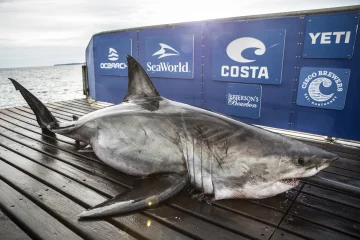The fall equinox as well as the changing of the seasons has triggered the yearly migration of great white sharks southward throughout America's East Coast.
Because as the climate cools, sharks are lured away towards typical northern feeding sites, such as Cape Cod and Nova Scotia, and toward warmer waters in Florida, Georgia, and also the Carolinas.
For nearly a decade, OCEARCH, a marine conservation organization, has been studying the migrations and movements of these sharks all across the North Atlantic. It expects that its insights will aid in the development of future conservation efforts to conserve these creatures in the face of climate change.
The researchers have found that these shark populations migrate north-south every year within their range, which stretches across Newfoundland to the eastern Gulf of Mexico, based on the organization's data.
Climate Patterns Affecting Shark Migrations
OCEARCH revealed the first south-bound shark of the season in a Facebook post: Andromache, a 340-pound great white that has started her yearly migration early for the past two years in succession.
For the previous three years, an abnormally extended La Niña climatic trend has persisted throughout the Pacific, bringing colder-than-average conditions to New England as well as the West Coast. This may have affected the sharks' yearly travels.
"Sharks travel alongside water temperature," Stephan Kajiura, a senior lecturer at Florida Atlantic University who investigates shark migration, told Newsweek. "They stay further in northern waters in warmer years and return sooner during the winter. We uncovered a [great] white shark in Massachusetts last summer within southeast Florida throughout the winter season."
Sharks' migrations fluctuate whenever the climate changes. "Because the temperature of the water is the main driver of migratory sea creatures, climate changes might alter animal behavior," Kajiura emphasized.
He, along with his colleagues, has been actively monitoring the migrations of another species of shark, the blacktip, which occupies the great white's territory.

Frequent Shark and Human Encounter
"We've observed numerous blacktip sharks migrating north than ever before," claimed Kajiura. "Those sharks seem to favor a distinct temperature distinction and will voyage within the same temperature range; now that sea temperatures are rising, the sharks are emigrating further northern in higher numbers to stay within their desired temperature."
Sharks, being top predators, perform a crucial part in the ocean's ecology, maintaining prey numbers in control and sustaining the general variety of aquatic systems. Differences in shark migration patterns may have an impact on the biodiversity in the areas where they regularly travel, lowering species variety in their former feeding grounds while harming prey numbers in their new home.
Human interactions involving creatures, such as the great white shark, may become more prevalent as global waters warm.
"Because global climate change leads water levels to increase, there will be not just more humans in the sea, but possibly many sharks in the same spot," added Kajiura. "This will create more interactions among both the two creatures," as he ended his remark.
RELATED ARTICLE: Giant 1,500lb Great White Shark Lurks Around Florida Shoreline After Swimming From Melbourne
Check out more news and information on Animals in Science Times.
© 2026 ScienceTimes.com All rights reserved. Do not reproduce without permission. The window to the world of Science Times.










